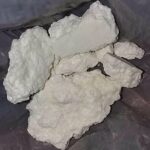2-Fluorodeschloroketamine (2-FDCK), also known as 2F-ketamine, is a designer drug sold as a research chemical. It is a dissociative anesthetic that is chemically similar to ketamine but has been reported to produce longer and more intense effects. The substance is sold online in various forms, including powder, crystals, and pellets.
Forms of 2-FDCK
- Powder and crystals: 2-FDCK is commonly sold in powder and crystal form, often intended for insufflation (snorting). Crystalline chunks may also be available.
- Pellets: 2-FDCK can also be purchased in pre-dosed pellets or pills for oral ingestion.
Effects and risks
Note: Due to 2-FDCK’s status as a New Psychoactive Substance (NPS), there is limited scientific research on its effects, dosage, and long-term risks. Information is largely based on user reports and animal studies.
Reported effects
- Dissociative and anesthetic: Like ketamine, 2-FDCK Powder Crystals & Pellets produces a disembodied or “dream-like” state, altered perceptions of reality, and can cause numbing sensations.
- Duration: The effects of 2-FDCK can last longer than those of ketamine. When insufflated, effects last 2–4 hours, while oral ingestion can prolong the effects to 3–5 hours.
- Mental effects: Users have reported feelings of relaxation, altered perception of time and space, confusion, and short-term memory impairment.
- High abuse potential: Studies have shown that 2-FDCK Powder Crystals & Pellets has an abuse potential comparable to ketamine.
Significant health risks
- Bladder damage: Frequent use of ketamine is known to cause bladder damage and inflammation, and researchers believe 2-FDCK use carries similar risks.
- Intense psychological states: High doses can lead to intense dissociative states known as a “k-hole,” which can be frightening and may lead to risky behavior, including self-mutilation.
- Dangerous combinations: Combining 2-FDCK with other drugs is not recommended and can be dangerous. Case reports show users often co-ingest 2-FDCK with other substances, including other ketamine analogues.
- Forensic cases: 2-FDCK has been detected in forensic cases involving driving under the influence and even fatalities.
- Co-ingestion with other analogues: It is common for other ketamine-type drugs, such as deschloroketamine (DCK) and 2-oxo-PCE, to be detected alongside 2-FDCK in toxicology reports



